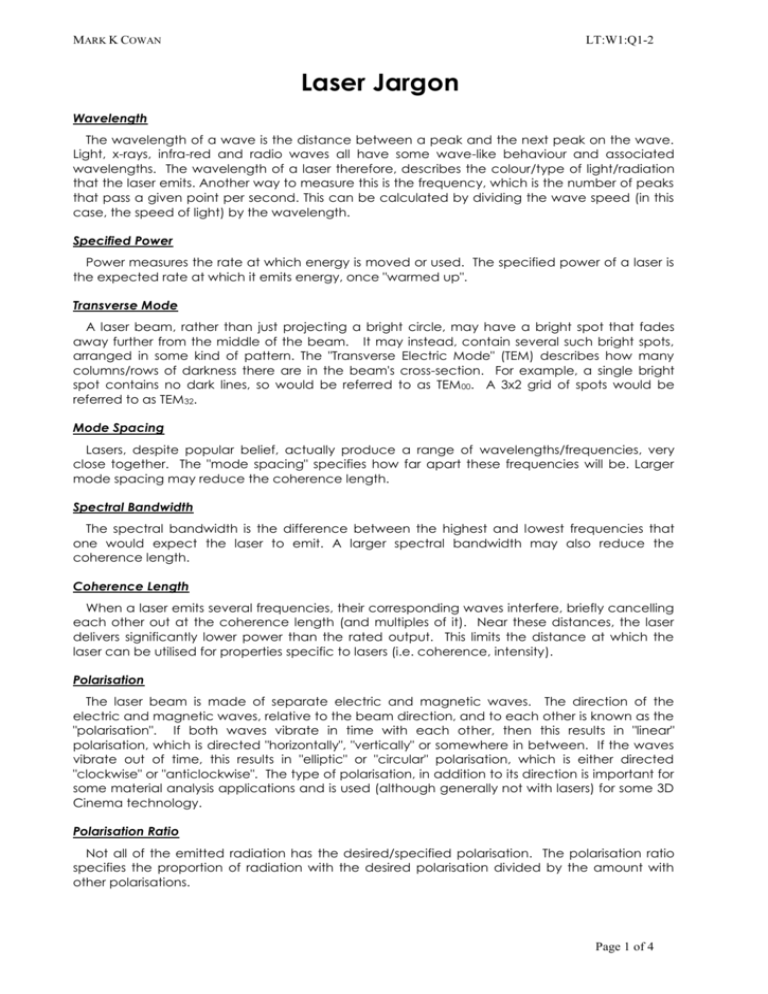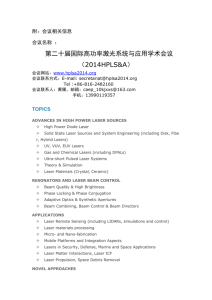1-laser - hackology.co.uk
advertisement

MARK K COWAN LT:W1:Q1-2 Laser Jargon Wavelength The wavelength of a wave is the distance between a peak and the next peak on the wave. Light, x-rays, infra-red and radio waves all have some wave-like behaviour and associated wavelengths. The wavelength of a laser therefore, describes the colour/type of light/radiation that the laser emits. Another way to measure this is the frequency, which is the number of peaks that pass a given point per second. This can be calculated by dividing the wave speed (in this case, the speed of light) by the wavelength. Specified Power Power measures the rate at which energy is moved or used. The specified power of a laser is the expected rate at which it emits energy, once "warmed up". Transverse Mode A laser beam, rather than just projecting a bright circle, may have a bright spot that fades away further from the middle of the beam. It may instead, contain several such bright spots, arranged in some kind of pattern. The "Transverse Electric Mode" (TEM) describes how many columns/rows of darkness there are in the beam's cross-section. For example, a single bright spot contains no dark lines, so would be referred to as TEM 00. A 3x2 grid of spots would be referred to as TEM32. Mode Spacing Lasers, despite popular belief, actually produce a range of wavelengths/frequencies, very close together. The "mode spacing" specifies how far apart these frequencies will be. Larger mode spacing may reduce the coherence length. Spectral Bandwidth The spectral bandwidth is the difference between the highest and lowest frequencies that one would expect the laser to emit. A larger spectral bandwidth may also reduce the coherence length. Coherence Length When a laser emits several frequencies, their corresponding waves interfere, briefly cancelling each other out at the coherence length (and multiples of it). Near these distances, the laser delivers significantly lower power than the rated output. This limits the distance at which the laser can be utilised for properties specific to lasers (i.e. coherence, intensity). Polarisation The laser beam is made of separate electric and magnetic waves. The direction of the electric and magnetic waves, relative to the beam direction, and to each other is known as the "polarisation". If both waves vibrate in time with each other, then this results in "linear" polarisation, which is directed "horizontally", "vertically" or somewhere in between. If the waves vibrate out of time, this results in "elliptic" or "circular" polarisation, which is either directed "clockwise" or "anticlockwise". The type of polarisation, in addition to its direction is important for some material analysis applications and is used (although generally not with lasers) for some 3D Cinema technology. Polarisation Ratio Not all of the emitted radiation has the desired/specified polarisation. The polarisation ratio specifies the proportion of radiation with the desired polarisation divided by the amount with other polarisations. Page 1 of 4 MARK K COWAN LT:W1:Q1-2 Noise (peak-to-peak) "Noise" is typically unwanted changes in the output intensity (although it can relate to other characteristics of the laser beam). The peak-to-peak noise is the difference between extreme values of the noise, as a percentage of the total beam intensity. As with most devices, "less noise is better". The peak-to-peak noise is of more importance in very sensitive applications - in others, the r.m.s noise is generally of more relevance. Noise (r.m.s) The r.m.s (root-mean-squared) noise in a beam is the average power emitted as "noise", as a percentage of the total power output of the laser. Laser noise can be seen as an optical equivalent to the hissing and buzzing that appears when using some analogue audio recordings/devices. Beam Diameter (1/e²) The width of the beam is difficult to measure and of limited use, as the beyond a certain angle from the beam direction, the intensity is almost zero. Instead, a useful measure of the beam size is the diameter of a circle in the beam's cross section, with the edge at where the beam intensity falls to e –2 (approximately 14%) of the peak intensity (at the centre). Beam Divergence For various reasons, a laser beam is not completely straight and parallel. Rather than a perfect cylinder, the beam widens with distance from the laser. The angle of widening, from the direction of the beam, is the beam divergence. Beam-pointing Stability The direction of the beam may vary slightly, depending on temperature and various other factors. The beam-pointing stability describes the range of the angle that the beam is likely to vary by, similar to measuring the "spray" of an automatic rifle. Power-stability The output power of a laser may vary slightly with time, possibly due to heating. The power stability describes how much the output power is likely to vary from a specified value, sometimes specified over a certain time-period. Page 2 of 4 MARK K COWAN LT:W1:Q1-2 Fibre lasers Laser light is often be transported along optical fibres. As the fibres are small, the light must first be focused onto them, and they must be physically aligned with the output aperture of the laser, in order to avoid "leaking" some of the source beam out. Lasers are generally less than 10% efficient, with most of the input energy being wasted by heating the equipment. Fibre lasers overcome these problems by generating the laser beam within an optical fibre. As the beam is generated within the fibre, alignment between the source and fibre is not needed, as the source is within the fibre. Laser light is generated gradually along a length of fibre, so the ratio of power-density to surface-area is very small. This means that the generated heat will be spread over a long strip of fibre, and can be extracted very quickly. The lifetime of the laser is therefore improved considerably, its stability is very good (due to reduced thermal fluctuations within the laser materials) and a much larger power output is available than is typically associated with lasers. Lasing within the fibre is often achieved by doping (adding small amounts of) Erbium to the fibre [1]. Erbium absorbs 978nm infrared readily, re-emitting the radiation at 1560nm [2]. A convenient way to supply the 978nm radiation is via diode lasers [1]. These are cheap, but produce beams that diverge considerably. To work around this, an outer-cladding is added around the doped fibre, with a reflective coating on the outside [1]. The diode light may then be "captured" within the cladding, reflecting within it along the fibre. Each time the diode light passes through the central (doped) fibre; some is absorbed - resulting in lasing [1]. While only 120mW of input (pump) power is needed to achieve lasing [2], power output in excess of 1kW Cladding Some radiation from diode “pump” laser “Pump” diode laser Erbium-doped optical fibre Laser beam generated within the fibre channel may be attained with fibre lasers [1]. Fig.A: Operation of a typical fibre laser [1] [2] http://www.orc.soton.ac.uk/61.html University of Southampton, How Fibre Lasers Work Mori A, Ohishi Y, Sudo S (1997). Erbium-doped tellurite glass fibre laser and amplifier. Electronics Letters 33: 863-864 Page 3 of 4 MARK K COWAN 1. LT:W1:Q1-2 Vertical Cavity Surface Emitting Lasers (VCSEL) [MAY BE SLIGHTLY INACCURATE] These lasers make use of Bragg reflections to form layers of highly reflective mirrors above and below an active region (the part of the device that can generate laser radiation) [3]. This high reflectivity (typically over 99.9% [3]) keeps most of the produced radiation contained within the active region (where amplification occurs), resulting in sustainable laser operation from even a weak supply current [5]. Radiation that escapes this region is still confined between the layers of distributed Bragg reflectors (DBRs) adjacent to the active region, resulting in standing waves. The spacing between the layers controls the preferred wavelength of standing waves, allowing the VCSELs to be "tuned" (during design) to allow a certain wavelength of radiation, while not permitting others - creating a very intense, monochromatic ("pure") and coherent ("in phase") beam [5]. The inactive regions between the distributed Bragg reflectors form "quantum wells" [5], analogous to the quantum mechanical "square well". The light is emitted perpendicular to the plane of the semiconductor wafers [3], allowing many VCSELs may be produced per wafer, allowing large arrays of them to be used to generate high output powers [3]. The low divergence of typical VCSEL beams allows such combining to remain efficient (partly due to low destructive interference as a result of the low divergence) even when thousands of individual VCSELs are used in an array [3]. The fast pulsing ability of these lasers also makes them ideal for high-speed digital communications [4]. Spacing DBRs between Active region Fig.B: Vertical-cavity surface emitting laser Over all, VCSEL devices are more efficient than conventional "edge-emitting" semiconductor lasers. They can be pulsed much faster [6] and the improved efficiency [6] allows them to deliver higher power in each pulse. These factors, combined with a more circular beam (edge-emitting laser beams are very oblate) allow them to be easily coupled with optical fibres [6]. Their vertical emission property allows them to be mass-produced at lower cost than their edge-emitting predecessors, allowing complete laser labs to be built into a single chip, and thousands of such chips to be produced at once [6]. [3] http://www.rp-photonics.com/vertical_cavity_surface_emitting_lasers.html RP Photonics, Encyclopedia of Laser Physics and Technology [4] Kenichi Iga (2008). Vertical-Cavity Surface-Emitting Laser: Its Conception and Evolution. Jpn. J. Appl. Phys. 47: 1-10 [5] http://www.sandia.gov/media/vcsel.htm Sandia National Laboratories, Patented laser device detects blood disorders near-instantly [6] http://www.fi.isc.cnr.it/users/giovanni.giacomelli/Semic/Samples/samples.html Giovanni Giacomelli, Istituto dei Sistemi Complessi, Introduction: semiconductor lasers Page 4 of 4






